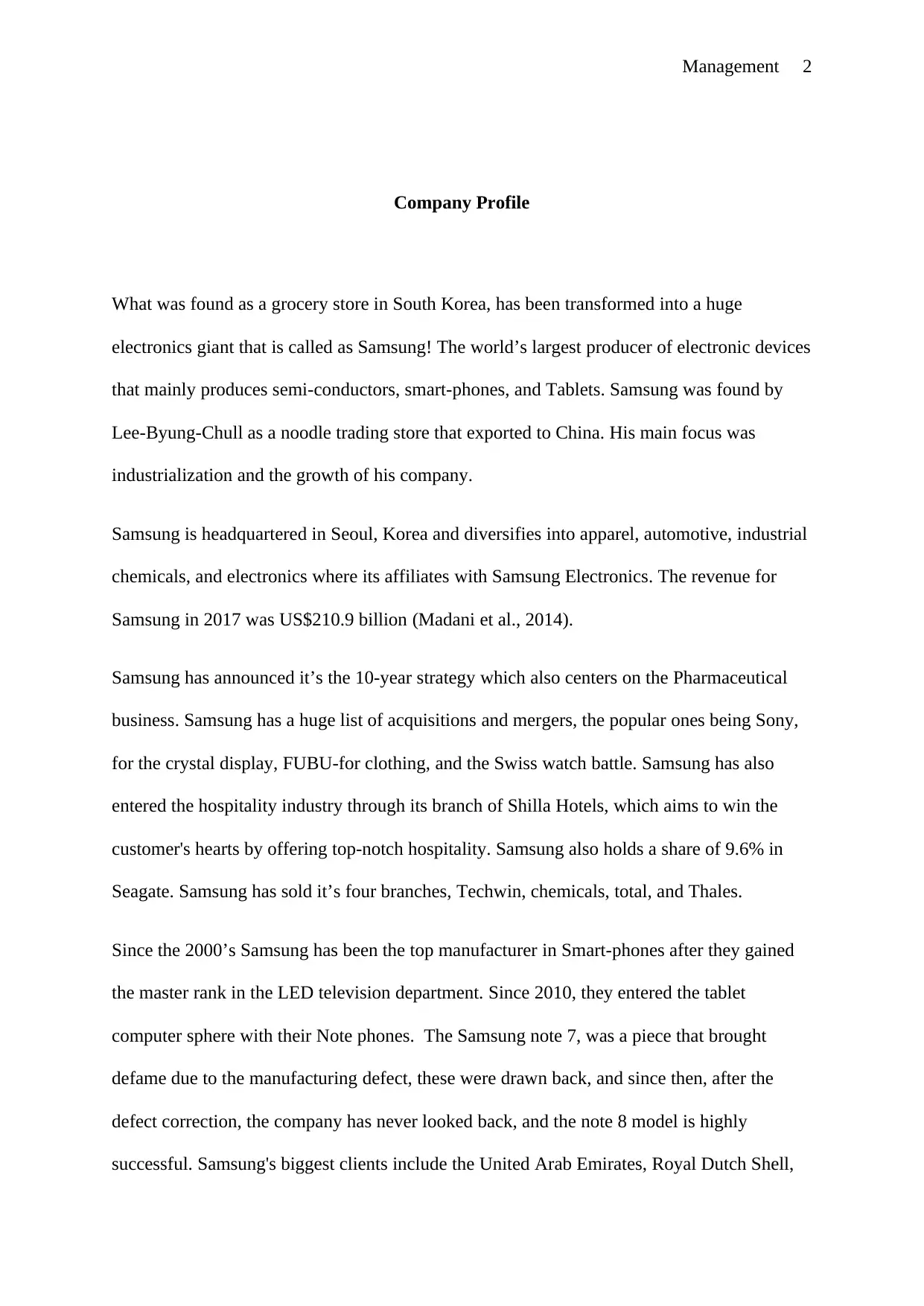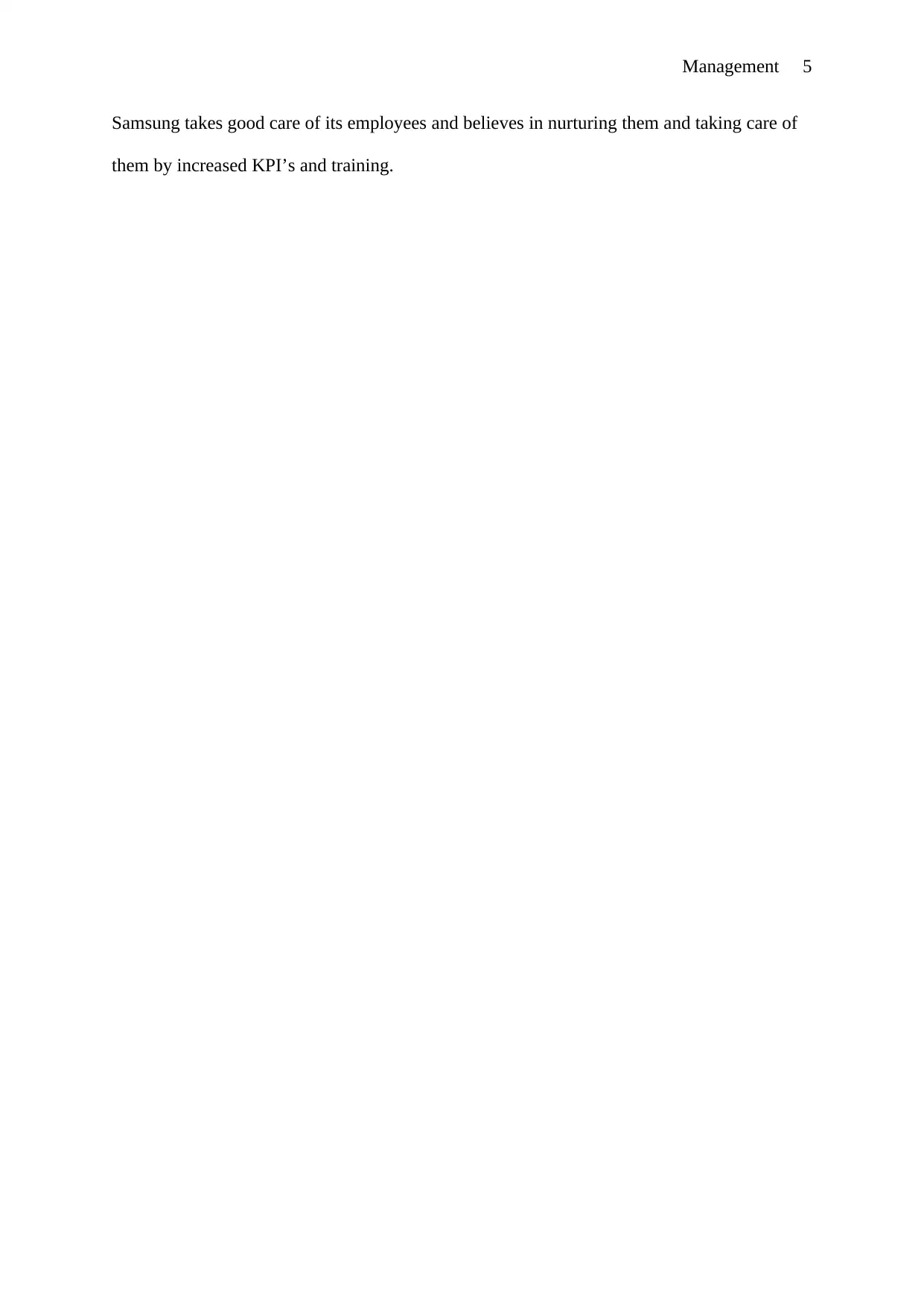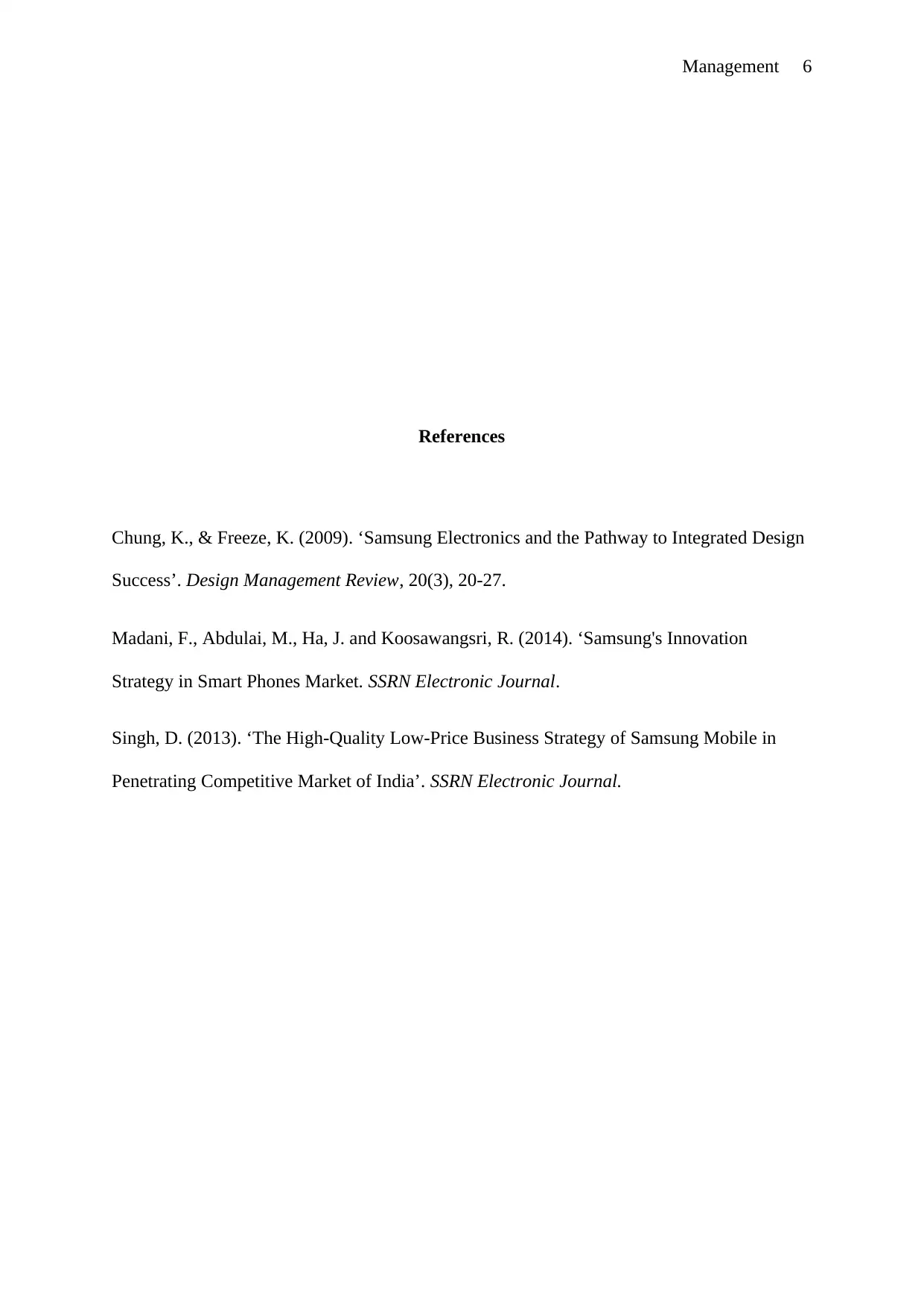Management 4, Semester 2: Samsung Company Analysis Report
VerifiedAdded on 2022/11/01
|6
|954
|170
Report
AI Summary
This report provides a comprehensive analysis of Samsung, a global electronics giant. It begins with a company profile, tracing Samsung's evolution from a noodle trading store to a leader in semiconductors, smartphones, and tablets. The report delves into Samsung's company performance, highlighting its market share, particularly in the smartphone sector, and discusses its strengths, such as innovation and brand recognition, alongside weaknesses like dependency on Android software and the challenges posed by competitors. A SWOT (Strengths, Weaknesses, Opportunities, and Threats) analysis is presented, followed by an examination of the company's balanced scorecard, focusing on financial, consumer, and social metrics. The report concludes with a review of Samsung's financial and social performance, emphasizing its strategic focus on stakeholder value and employee well-being, supported by relevant references.

Management 1
TITLE OF THE PAPER CENTERED AND IN CAPS LOCK
by Student’s Name
Code + Course Name
Professor’s Name
University Name
City, State
Date
TITLE OF THE PAPER CENTERED AND IN CAPS LOCK
by Student’s Name
Code + Course Name
Professor’s Name
University Name
City, State
Date
Paraphrase This Document
Need a fresh take? Get an instant paraphrase of this document with our AI Paraphraser

Management 2
Company Profile
What was found as a grocery store in South Korea, has been transformed into a huge
electronics giant that is called as Samsung! The world’s largest producer of electronic devices
that mainly produces semi-conductors, smart-phones, and Tablets. Samsung was found by
Lee-Byung-Chull as a noodle trading store that exported to China. His main focus was
industrialization and the growth of his company.
Samsung is headquartered in Seoul, Korea and diversifies into apparel, automotive, industrial
chemicals, and electronics where its affiliates with Samsung Electronics. The revenue for
Samsung in 2017 was US$210.9 billion (Madani et al., 2014).
Samsung has announced it’s the 10-year strategy which also centers on the Pharmaceutical
business. Samsung has a huge list of acquisitions and mergers, the popular ones being Sony,
for the crystal display, FUBU-for clothing, and the Swiss watch battle. Samsung has also
entered the hospitality industry through its branch of Shilla Hotels, which aims to win the
customer's hearts by offering top-notch hospitality. Samsung also holds a share of 9.6% in
Seagate. Samsung has sold it’s four branches, Techwin, chemicals, total, and Thales.
Since the 2000’s Samsung has been the top manufacturer in Smart-phones after they gained
the master rank in the LED television department. Since 2010, they entered the tablet
computer sphere with their Note phones. The Samsung note 7, was a piece that brought
defame due to the manufacturing defect, these were drawn back, and since then, after the
defect correction, the company has never looked back, and the note 8 model is highly
successful. Samsung's biggest clients include the United Arab Emirates, Royal Dutch Shell,
Company Profile
What was found as a grocery store in South Korea, has been transformed into a huge
electronics giant that is called as Samsung! The world’s largest producer of electronic devices
that mainly produces semi-conductors, smart-phones, and Tablets. Samsung was found by
Lee-Byung-Chull as a noodle trading store that exported to China. His main focus was
industrialization and the growth of his company.
Samsung is headquartered in Seoul, Korea and diversifies into apparel, automotive, industrial
chemicals, and electronics where its affiliates with Samsung Electronics. The revenue for
Samsung in 2017 was US$210.9 billion (Madani et al., 2014).
Samsung has announced it’s the 10-year strategy which also centers on the Pharmaceutical
business. Samsung has a huge list of acquisitions and mergers, the popular ones being Sony,
for the crystal display, FUBU-for clothing, and the Swiss watch battle. Samsung has also
entered the hospitality industry through its branch of Shilla Hotels, which aims to win the
customer's hearts by offering top-notch hospitality. Samsung also holds a share of 9.6% in
Seagate. Samsung has sold it’s four branches, Techwin, chemicals, total, and Thales.
Since the 2000’s Samsung has been the top manufacturer in Smart-phones after they gained
the master rank in the LED television department. Since 2010, they entered the tablet
computer sphere with their Note phones. The Samsung note 7, was a piece that brought
defame due to the manufacturing defect, these were drawn back, and since then, after the
defect correction, the company has never looked back, and the note 8 model is highly
successful. Samsung's biggest clients include the United Arab Emirates, Royal Dutch Shell,

Management 3
and the Ontario government. These are dealt with by Samsung Heavy Industries, for energy
resources and Shipping. This is another area where Samsung has excelled in.
Company Performance
Samsung holds the highest market share in terms of Smart Phone users, i.e. 23.5%. but, its
drawback of not owning Android software and a lot of unpatented technologies leads to a lot
of market competition from companies like Huawei and Apple.
The major market of Samsung is the middle class, which wants good technology with less
investment. This market has been captured by Huawei, which has given Samsung a huge
competition. With the defects in Note 7, the market for high-end Samsung products declined.
This went south-hill when Airlines did not allow any passenger-carrying Note 7 boarding the
flight.
Strength
Huge range of products
Innovation
Brand name
Great marketing
Weakness
No software patent
Dependant for phone software
Easily copied
Opportunities
Capturing the Indian Market
Indian market thrives on “show-off” and
premium products have a great sale
Threats
Maximum low-income consumers captured
by Huawei
LG and Google taking over the premium
market
Apple’s Monopoly
and the Ontario government. These are dealt with by Samsung Heavy Industries, for energy
resources and Shipping. This is another area where Samsung has excelled in.
Company Performance
Samsung holds the highest market share in terms of Smart Phone users, i.e. 23.5%. but, its
drawback of not owning Android software and a lot of unpatented technologies leads to a lot
of market competition from companies like Huawei and Apple.
The major market of Samsung is the middle class, which wants good technology with less
investment. This market has been captured by Huawei, which has given Samsung a huge
competition. With the defects in Note 7, the market for high-end Samsung products declined.
This went south-hill when Airlines did not allow any passenger-carrying Note 7 boarding the
flight.
Strength
Huge range of products
Innovation
Brand name
Great marketing
Weakness
No software patent
Dependant for phone software
Easily copied
Opportunities
Capturing the Indian Market
Indian market thrives on “show-off” and
premium products have a great sale
Threats
Maximum low-income consumers captured
by Huawei
LG and Google taking over the premium
market
Apple’s Monopoly
⊘ This is a preview!⊘
Do you want full access?
Subscribe today to unlock all pages.

Trusted by 1+ million students worldwide

Management 4
The SWOT analysis of the company shows us the data that is equated by its balanced
scorecard. The strengths of Samsung are its marketing, innovation and a huge range of
products. The weaknesses are unpatented technology and the dependency on others for
software as it has none of its own (Chung & Freeze, 2009, p.20-27).
However, it has been capturing great opportunities like the Indian Market, which is
continually growing. But, this also is a potential threat, as; this market has many competitors
like LG and Apple. Also, extreme currency fluctuations don’t allow a steady income (Singh,
2013).
When we come to the balanced scorecard, it has more lead indicators and fewer lag
indicators, thus promising a positive outcome. Samsung’s ultimate motive is to increase
stakeholder's value. It has been gearing up its products for its best and avoiding every
possible repair and refund issues that could come up.
Metric Lead indicator Lag indicator
Financial
More value to shareholders
Low operating costs
Increase in share and
dividend value
Low operating costs
Low revenues
Good marketing campaign
Brand value recognition
Consumer
Increase market share
Up to 23.5% Note 7 credibility still
questioned
Economically, the revenues of Samsung have gone up in the past quarter, for the last two
years, after its meltdown with battery defects in Note 7, Samsung has gone up, gained the
advantage with its tablet phone range in Note 8, and is set to introduce Note 9. Socially,
The SWOT analysis of the company shows us the data that is equated by its balanced
scorecard. The strengths of Samsung are its marketing, innovation and a huge range of
products. The weaknesses are unpatented technology and the dependency on others for
software as it has none of its own (Chung & Freeze, 2009, p.20-27).
However, it has been capturing great opportunities like the Indian Market, which is
continually growing. But, this also is a potential threat, as; this market has many competitors
like LG and Apple. Also, extreme currency fluctuations don’t allow a steady income (Singh,
2013).
When we come to the balanced scorecard, it has more lead indicators and fewer lag
indicators, thus promising a positive outcome. Samsung’s ultimate motive is to increase
stakeholder's value. It has been gearing up its products for its best and avoiding every
possible repair and refund issues that could come up.
Metric Lead indicator Lag indicator
Financial
More value to shareholders
Low operating costs
Increase in share and
dividend value
Low operating costs
Low revenues
Good marketing campaign
Brand value recognition
Consumer
Increase market share
Up to 23.5% Note 7 credibility still
questioned
Economically, the revenues of Samsung have gone up in the past quarter, for the last two
years, after its meltdown with battery defects in Note 7, Samsung has gone up, gained the
advantage with its tablet phone range in Note 8, and is set to introduce Note 9. Socially,
Paraphrase This Document
Need a fresh take? Get an instant paraphrase of this document with our AI Paraphraser

Management 5
Samsung takes good care of its employees and believes in nurturing them and taking care of
them by increased KPI’s and training.
Samsung takes good care of its employees and believes in nurturing them and taking care of
them by increased KPI’s and training.

Management 6
References
Chung, K., & Freeze, K. (2009). ‘Samsung Electronics and the Pathway to Integrated Design
Success’. Design Management Review, 20(3), 20-27.
Madani, F., Abdulai, M., Ha, J. and Koosawangsri, R. (2014). ‘Samsung's Innovation
Strategy in Smart Phones Market. SSRN Electronic Journal.
Singh, D. (2013). ‘The High-Quality Low-Price Business Strategy of Samsung Mobile in
Penetrating Competitive Market of India’. SSRN Electronic Journal.
References
Chung, K., & Freeze, K. (2009). ‘Samsung Electronics and the Pathway to Integrated Design
Success’. Design Management Review, 20(3), 20-27.
Madani, F., Abdulai, M., Ha, J. and Koosawangsri, R. (2014). ‘Samsung's Innovation
Strategy in Smart Phones Market. SSRN Electronic Journal.
Singh, D. (2013). ‘The High-Quality Low-Price Business Strategy of Samsung Mobile in
Penetrating Competitive Market of India’. SSRN Electronic Journal.
⊘ This is a preview!⊘
Do you want full access?
Subscribe today to unlock all pages.

Trusted by 1+ million students worldwide
1 out of 6
Related Documents
Your All-in-One AI-Powered Toolkit for Academic Success.
+13062052269
info@desklib.com
Available 24*7 on WhatsApp / Email
![[object Object]](/_next/static/media/star-bottom.7253800d.svg)
Unlock your academic potential
Copyright © 2020–2025 A2Z Services. All Rights Reserved. Developed and managed by ZUCOL.





